 |
Cheat Engine
The Official Site of Cheat Engine
|
| View previous topic :: View next topic |
| Author |
Message |
Lexdyslic
How do I cheat?
![]() Reputation: 0 Reputation: 0
Joined: 19 May 2020
Posts: 6
|
 Posted: Tue May 19, 2020 9:30 am Post subject: Two copy memory opcodes in debugger Posted: Tue May 19, 2020 9:30 am Post subject: Two copy memory opcodes in debugger |
 |
|
I'm attempting to find the pointer for levitation in a game called Noita, I've managed to find the address perfectly fine however after seeing what accesses the address there are two copy memory opcodes in the debugger. After trying each of these and searching for the probable address I get no values whatsoever as you can see in screenshot #1.
After doing more reading I found that the possible cause is a pointer chain, so after manually putting in the probable addresses (of which only one of them yielded a value) and seeing what accesses the pointers the exact same 2 copy memory opcodes are found (in screenshot #3).
I'm a complete beginner with using cheat engine and figured I'd use (what i thought) was a simple 2D indie game to try it out and this has me stumped.
| Description: |
|
| Filesize: |
194.15 KB |
| Viewed: |
5412 Time(s) |
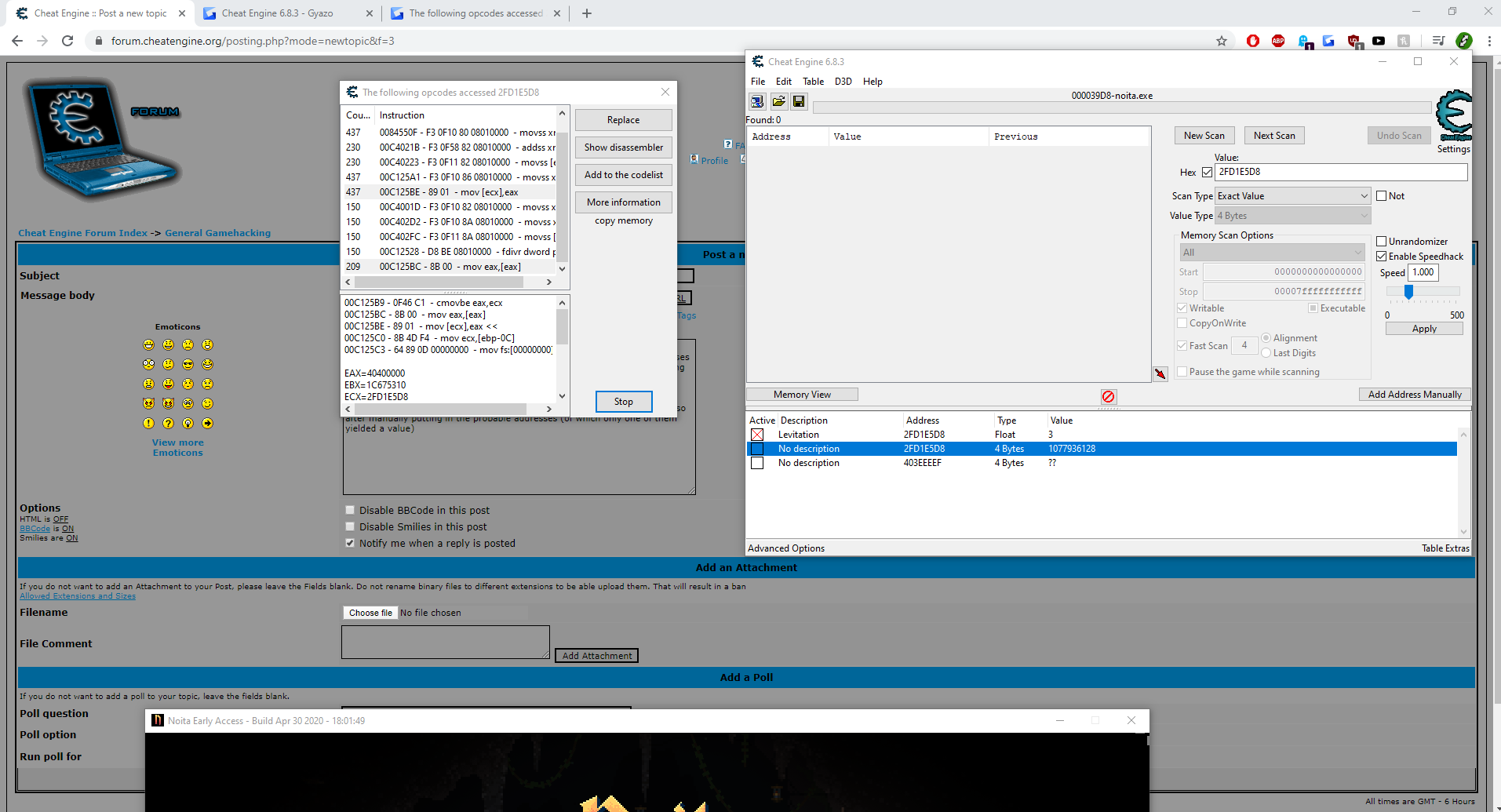
|
| Description: |
|
| Filesize: |
167.86 KB |
| Viewed: |
5412 Time(s) |
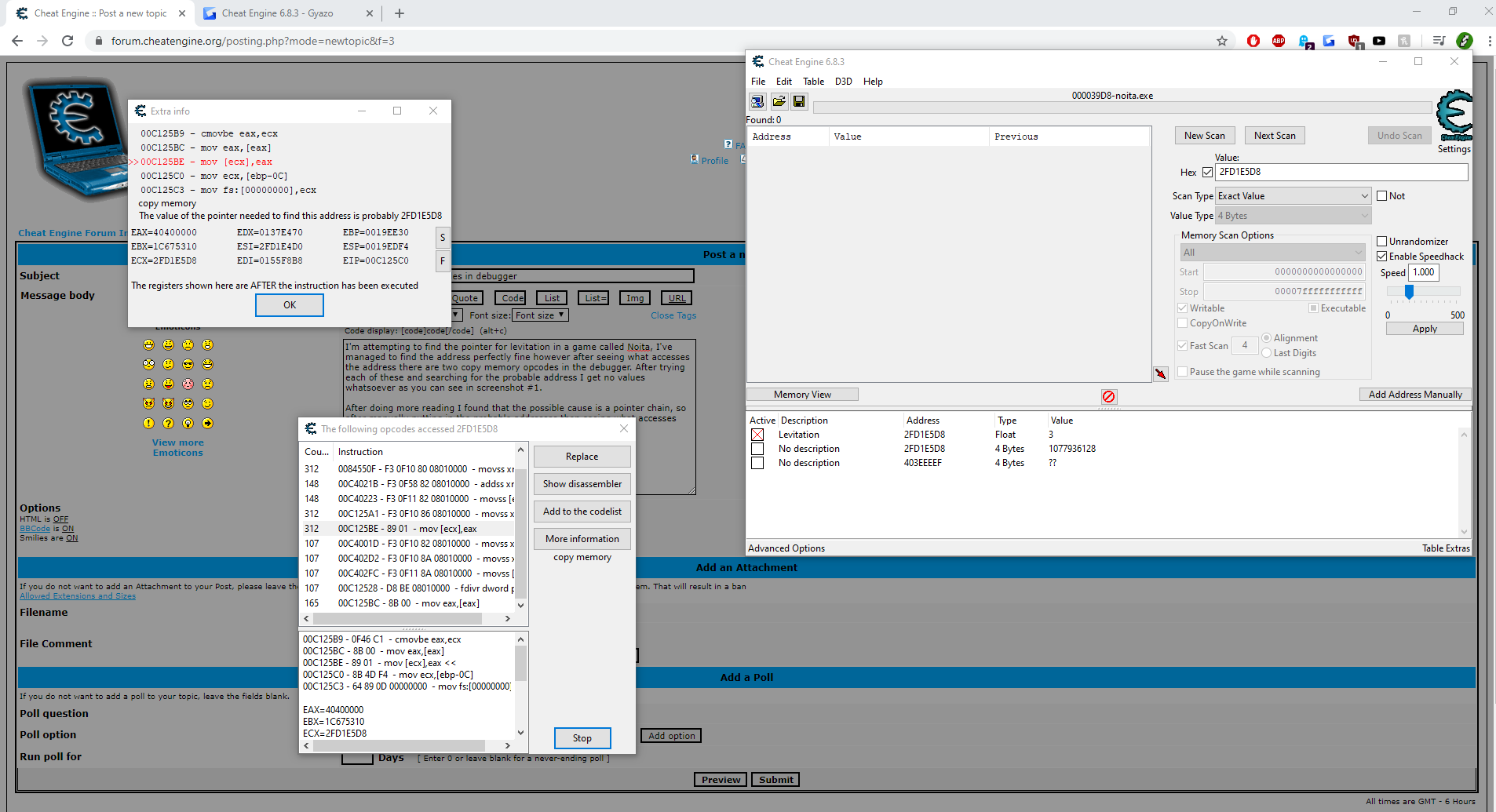
|
| Description: |
|
| Filesize: |
157.6 KB |
| Viewed: |
5412 Time(s) |
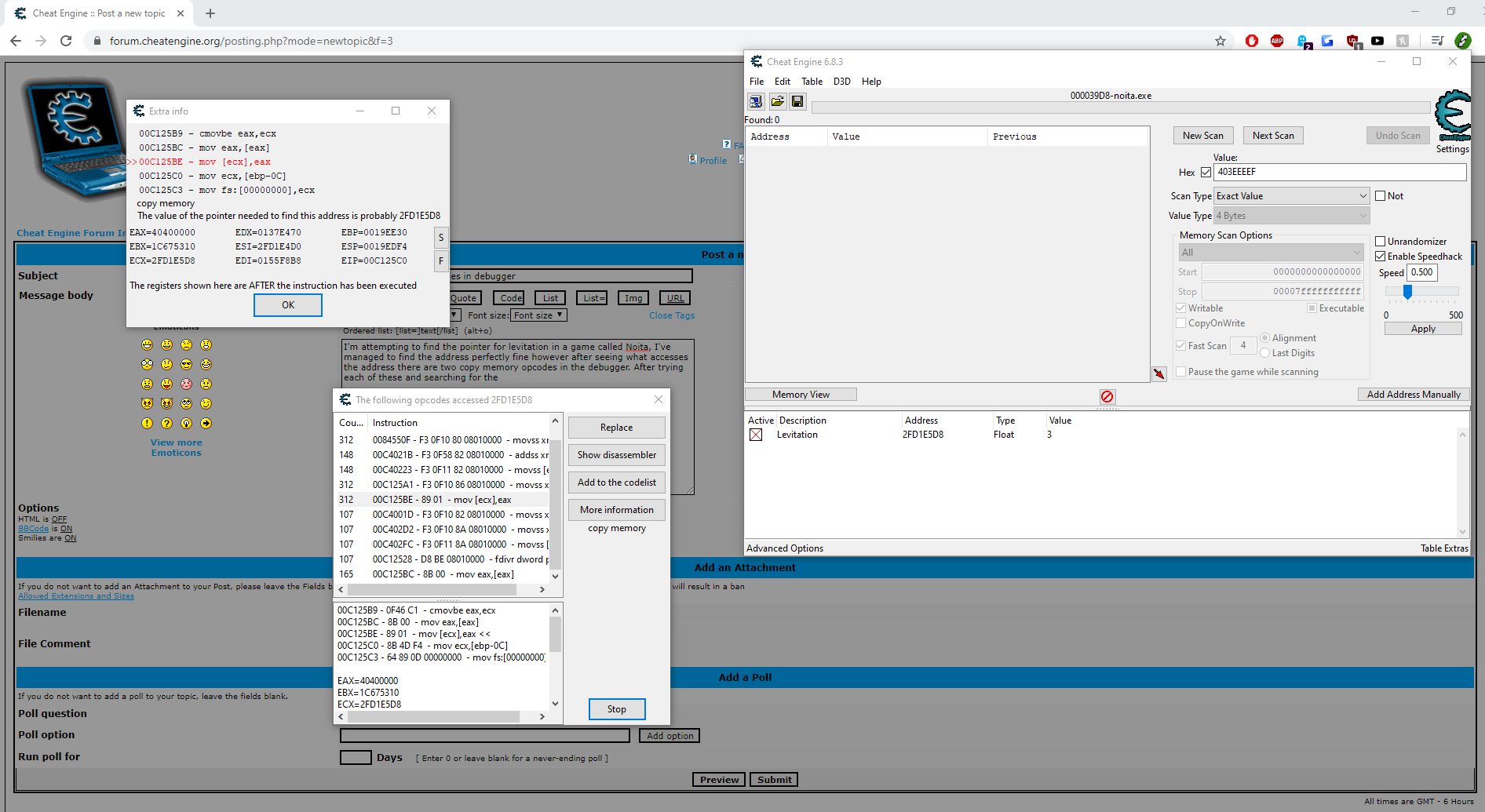
|
|
|
| Back to top |
|
 |
ParkourPenguin
I post too much
 Reputation: 140 Reputation: 140
Joined: 06 Jul 2014
Posts: 4300
|
 Posted: Tue May 19, 2020 10:25 am Post subject: Posted: Tue May 19, 2020 10:25 am Post subject: |
 |
|
Do those SSE instructions use an offset? You're not limited to just using mov instructions. Moreover, you'd want to avoid instructions that operate on integer or generic data (i.e. mov) when working with floating point numbers.
Have you tried the pointer scanner? See this video for an example.
In "Noita debugger screenshot 3.png", you're looking at the exact same address. The only difference between them is that you're interpreting the 0s and 1s in memory in a different way (integer vs floating point number).
_________________
I don't know where I'm going, but I'll figure it out when I get there. |
|
| Back to top |
|
 |
Lexdyslic
How do I cheat?
![]() Reputation: 0 Reputation: 0
Joined: 19 May 2020
Posts: 6
|
 Posted: Tue May 19, 2020 11:53 am Post subject: Posted: Tue May 19, 2020 11:53 am Post subject: |
 |
|
Gah, I just typed out a full response and my internet cut out and I lost it. Anyway, all I know about offsets is that they are whatever is in the red square bracket in the 'extra info' window after you double click on an opcode in the debugger screen so i guess they don't use an offset?
Also I tried using the pointer scanner but the tutorial (same one that you linked) is a bit difficult to apply to an actual game, what I did didn't show anything after doing the pointer scan so I'll just type out what I did.
I found the levitation address by scanning and increasing/decreasing the value till i narrowed down the value and found it through trial and error. Then I added that address to the list and generated a pointer map for it and saved it. Then i closed the game down and repeated the same step to get the address and did a pointer scan, making sure to select the same file that I saved before I closed the game. However after waiting for the scan to finish nothing showed up in any of the file types (4 byte, float etc etc).
I understand that the method that I was doing before was the manual way which i got from a tutorial I found on the fearless forums. I don't know the significance of the 'copy memory' opcode I was just following the tutorial I found there which just said to double click on the one that had that to find the probably address and the offset (which the tutorial described as being the text/numbers in the square bracket).
|
|
| Back to top |
|
 |
ParkourPenguin
I post too much
 Reputation: 140 Reputation: 140
Joined: 06 Jul 2014
Posts: 4300
|
 Posted: Tue May 19, 2020 12:17 pm Post subject: Posted: Tue May 19, 2020 12:17 pm Post subject: |
 |
|
| Lexdyslic wrote: | | so i guess they don't use an offset? |
Just to be clear, you're looking at the SSE instructions (i.e. movss, addss, fdivr) and not the mov instructions, correct?
| Lexdyslic wrote: | | Then i closed the game down and repeated the same step to get the address and did a pointer scan, making sure to select the same file that I saved before I closed the game. However after waiting for the scan to finish nothing showed up in any of the file types (4 byte, float etc etc). |
4 byte and float are value types. They aren't really relevant either- pointer scans find pointer paths to addresses.
What did you use for the address to find in the first pointer map when you did the scan? It should be set to the address you found when you generated the pointer map.
According to the game's website, the game engine is written in c++, so there should be some pointer paths to it. Did you disable initial stack space of threads being treated as static in the pointer scan settings? You may need to increase the max level or offset in the pointer scan settings.
_________________
I don't know where I'm going, but I'll figure it out when I get there. |
|
| Back to top |
|
 |
Lexdyslic
How do I cheat?
![]() Reputation: 0 Reputation: 0
Joined: 19 May 2020
Posts: 6
|
 Posted: Tue May 19, 2020 7:04 pm Post subject: Posted: Tue May 19, 2020 7:04 pm Post subject: |
 |
|
Okay, I took a break and came back to it, the address that I used in the first pointer map was the one that I found by narrowing down the addresses by doing the unknown initial value scan (35ACB720).
I closed the game down, found the levitation address again (this time 3288C810) then did a pointer scan on that address and comparing it with the first address that i did the pointer map of. There was only one address in the drop down menu in the pointer scanner screen, that being 35ACB720. This is what my screen looked like (in pointer scanner+address list.png).
After letting the scanner work the pointer scan screen was blank (shown in pointer scanner.png)
As for when I was doing it manually, I wasn't looking at the movss,addss,fdivr instructions as I was just following a tutorial that didn't shed any light on the significance of those for that step. After looking them up is this because movss/addss is for moving/adding float values which is what the original value is?
In the tutorial that you linked just the defaults were used for the pointer scanner so i left it at that.
| Description: |
|
| Filesize: |
9.69 KB |
| Viewed: |
5358 Time(s) |

|
| Description: |
|
| Filesize: |
45.62 KB |
| Viewed: |
5358 Time(s) |
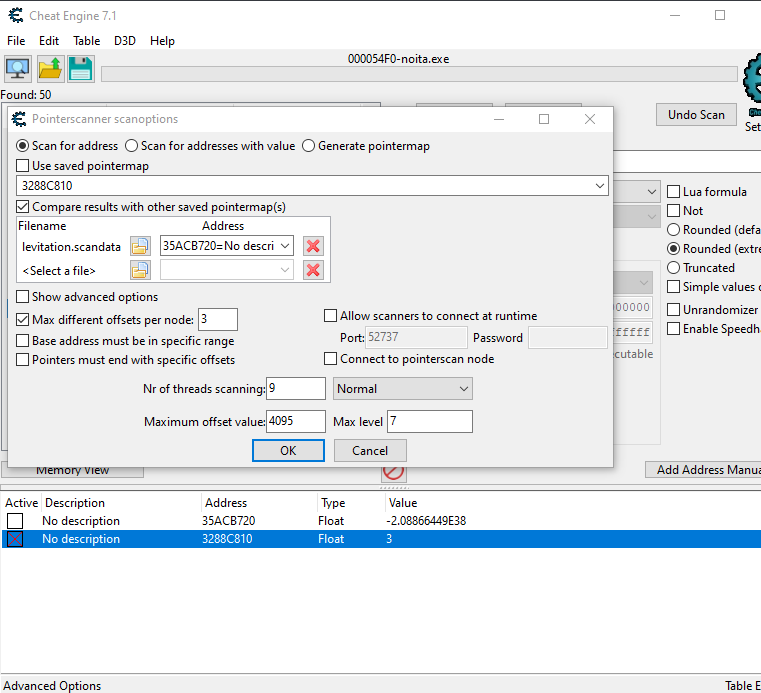
|
|
|
| Back to top |
|
 |
ParkourPenguin
I post too much
 Reputation: 140 Reputation: 140
Joined: 06 Jul 2014
Posts: 4300
|
 Posted: Tue May 19, 2020 8:47 pm Post subject: Posted: Tue May 19, 2020 8:47 pm Post subject: |
 |
|
The pointer scan settings look fine, as long as you didn't change any of the advanced settings. I guess you'd have to increase the max different offsets per node (or disable it completely), or maybe increase max offset / level. Increase it enough and you might die before the scan finnishes... it's probably worth looking into manually before trying the pointer scanner again.
| Lexdyslic wrote: | | As for when I was doing it manually, I wasn't looking at the movss,addss,fdivr instructions as I was just following a tutorial that didn't shed any light on the significance of those for that step. After looking them up is this because movss/addss is for moving/adding float values which is what the original value is? |
When you're looking for an offset to use in a pointer path, the instruction that accesses the value doesn't really matter. All that matters is how the instruction accesses it: the offset the instruction uses.
So, third time now: what is the offset those other instructions use? You can write down the instructions like this:
| Code: | // this is just an example: I don't know what comes after movss xmm...
0084550F - movss xmm0,[rsi+3C]
etc. |
Or post an image of the "The following opcodes accessed..." window as you did in the first post but resized horizontally and vertically so all of the instructions can be seen in their entirety.
_________________
I don't know where I'm going, but I'll figure it out when I get there. |
|
| Back to top |
|
 |
Lexdyslic
How do I cheat?
![]() Reputation: 0 Reputation: 0
Joined: 19 May 2020
Posts: 6
|
 Posted: Wed May 20, 2020 12:50 am Post subject: Posted: Wed May 20, 2020 12:50 am Post subject: |
 |
|
Heres the opcode window, sorry about dragging out what is probably a simple issue I just wanted to get a better understanding of what I'm doing first (hence all the questions).
| Description: |
|
| Filesize: |
99.67 KB |
| Viewed: |
5346 Time(s) |

|
|
|
| Back to top |
|
 |
ParkourPenguin
I post too much
 Reputation: 140 Reputation: 140
Joined: 06 Jul 2014
Posts: 4300
|
 Posted: Wed May 20, 2020 10:21 am Post subject: Posted: Wed May 20, 2020 10:21 am Post subject: |
 |
|
Asking questions is fine.
The offset is 0x108. The address you should scan for would be the address you're watching (i.e. 30FEB4E8) minus that offset:
30FEB4E8 - 108 = 30FEB3E0
Scan for that value as a 4-byte hexadecimal value. For all the results that come up, check what accesses each one and recursively repeat this process. If you do stuff in the game for a bit (e.g. attack, change levels, return to main menu and reenter the game, reload a save, whatever) and nothing accesses an address, it's fine to skip it and try the next one. Take notes as you go along.
The following isn't pragmatic but it's of pedagogical concern.
Values tend to be grouped together into structures, and structures typically include other structures in them by pointers. These pointers point to the beginning (aka base) of other structures. The values in those other structures are typically accessed through an offset from the base of the structure they're in.
In your previous post, 30FEB4E8 is the address of the value you want, 30FEB3E0 is almost certainly the base of the structure that value is in, and by scanning for the 4-byte hex value 30FEB3E0, you're basically asking "Where are all the pointers that point to this structure?" Those other pointers are probably contained in structures themselves, and you'll need to recursively repeat this process until you get to something static.
The two mov instructions aren't relevant in this specific case because they aren't using any offset and there are other instructions that do use an offset. Those two mov instructions are probably part of some function that operates on generic data. They aren't tailored to any specific value or structure, so they need to be passed the address of the value to operate on directly.
_________________
I don't know where I'm going, but I'll figure it out when I get there. |
|
| Back to top |
|
 |
Lexdyslic
How do I cheat?
![]() Reputation: 0 Reputation: 0
Joined: 19 May 2020
Posts: 6
|
 Posted: Wed May 20, 2020 1:41 pm Post subject: Posted: Wed May 20, 2020 1:41 pm Post subject: |
 |
|
Okay that makes sense, I definitely have a better idea of how this is structured and what i'm doing by finding the pointers.
Although after scanning 30FEB3E0 it only yielded 2 addresses, and after checking what accesses these addresses i didn't get anything in the debugger. After searching around the forums I saw that maybe switching the method from windows to VEH might help then reopening the game, after doing that (and doing everything up to now again) it yielded 64 addresses. All of these addresses aside from the last one didn't have anything after checking what accesses them. this is what is in the screenshot.
My question now is, what is the offset? After looking up the x86 Assembly language on wikipedia I see that in the red the offset should be something like eax*4 and in the extra info panel it says that eax = 311B5128. Does that mean that since it's the same (probable) address that it's like saying 0*4 = 0? (0 being the offset).
| Description: |
|
| Filesize: |
88.28 KB |
| Viewed: |
5298 Time(s) |
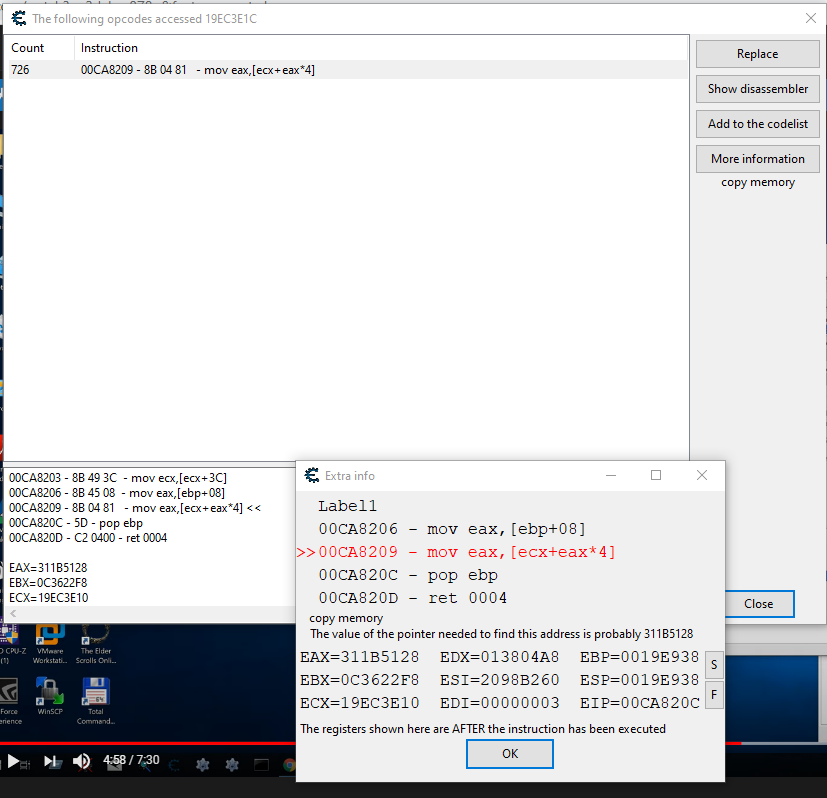
|
|
|
| Back to top |
|
 |
ParkourPenguin
I post too much
 Reputation: 140 Reputation: 140
Joined: 06 Jul 2014
Posts: 4300
|
 Posted: Wed May 20, 2020 2:22 pm Post subject: Posted: Wed May 20, 2020 2:22 pm Post subject: |
 |
|
| Lexdyslic wrote: | | Although after scanning 30FEB3E0 it only yielded 2 addresses |
Dynamic addresses can change when the game restarts. Unless you kept the game open the entire time, it would've changed, and 30FEB3E0 would be something else entirely.
| Lexdyslic wrote: | | after doing that (and doing everything up to now again)... |
"everything" should just include finding a value and looking at what accesses it.
| Lexdyslic wrote: | | All of these addresses aside from the last one didn't have anything after checking what accesses them. |
Did you remember to do stuff in the game while watching what instructions access the addresses? I gave generic examples in my previous post. If you clicked "Find out what instructions access this address" and then did nothing in the game, you did it wrong.
| Lexdyslic wrote: | | My question now is, what is the offset? After looking up the x86 Assembly language on wikipedia I see that in the red the offset should be something like eax*4 and in the extra info panel it says that eax = 311B5128. |
The extra info panel also says "The registers shown here are AFTER the instruction has been executed".
That instruction obviously accessed your address, so you know ecx+eax*4=19EC3E1C. eax was modified, so its value is unknown; however, ecx wasn't modified, so you know ecx=19EC3E10. That's pretty close to the address you're watching accesses to, so it's probably the base. The offset would then be 19EC3E1C - 19EC3E10 = C.
Personally, I'd look for some other path before diving into this one. This looks like it's in some sort of array, and its position in the array might change when the game is restarted or even during runtime.
_________________
I don't know where I'm going, but I'll figure it out when I get there. |
|
| Back to top |
|
 |
Lexdyslic
How do I cheat?
![]() Reputation: 0 Reputation: 0
Joined: 19 May 2020
Posts: 6
|
 Posted: Wed May 20, 2020 2:39 pm Post subject: Posted: Wed May 20, 2020 2:39 pm Post subject: |
 |
|
Yeah up until after i scanned 30FEB3E0 i had kept the game open the entire time, and after each time I accessed the address i spent about 20 seconds in each of the 64 addresses doing random things in game before pausing the game again then moving to the next address to check.
How did you first get into using cheat engine? Do you have a formal education in programming or are you self taught? I feel as if I should probably get a better base understanding first before trying to do this as looking up everything only going to get me so far (currently no where). Do you have any recommendations on things I should learn before trying to tackle doing things like this?
|
|
| Back to top |
|
 |
ParkourPenguin
I post too much
 Reputation: 140 Reputation: 140
Joined: 06 Jul 2014
Posts: 4300
|
 Posted: Wed May 20, 2020 4:54 pm Post subject: Posted: Wed May 20, 2020 4:54 pm Post subject: |
 |
|
If that pointer path doesn't work out, I'm not sure where you can easily go from here. You could try increasing the max level / offset on the pointer scanner. Tick "Pointers must end with specific offsets" and put 108 as the only offset- it'll speed up scans.
Everything else I can think of involves assembly.
| Lexdyslic wrote: | | How did you first get into using cheat engine? Do you have a formal education in programming or are you self taught? I feel as if I should probably get a better base understanding first before trying to do this as looking up everything only going to get me so far (currently no where). Do you have any recommendations on things I should learn before trying to tackle doing things like this? |
As a small child many years ago (long before I joined these forums) I looked up how to cheat in some flash game, which lead me to CE. I knew literally nothing at the beginning and got by with others' tables. What little success I had on my own usually came from trial and error in scanning for values. I tried to get into assembly, failed, and forgot about it for a while.
What really helped me out was learning C++. Again, I first tried and failed. There's a lot of bad resources out there, but several years later, I happened on enough good ones that I was able to get pretty good at it after a couple years. C++ isn't required to learn assembly, but having something else to draw connections to helps a lot.
I started learning assembly by watching an intro to x86 youtube playlist. It wasn't good and there are better resources out there now, but it was a better foundation than nothing. When reading assembly, if I didn't know what an instruction did and context didn't help, I looked it up in an instruction set reference and recursively looked up terms I didn't know. Over the course of a few months, I went from being bad to adequate. I eventually got good by reading Intel's software developer's manuals, but they weren't written for beginners.
Merely knowing what assembly does is different from understanding what the code is doing at a higher level. Getting good at a systems programming language (C, C++, rust, etc.) and more generic programming concepts (algorithms & data structures) are important, and tools like godbolt (compiler explorer) are indispensable. You might look into learning reverse engineering at this point, but that might be overkill if all you're using is CE.
There's enough open resources to learn this on your own. e.g. MIT's OCW is good, and stackoverflow has a list of good C++ books. I don't have any particular resources on x86 / x64 architecture I'd recommend, but search engines can find stuff.
Doing what you're doing is how I got through it. Try something, get as far as you can, and when you get tired, set the project aside for whatever length of time- even forever is fine. A vicious or dubious morale hinders progress, while just being exposed to problems will improve more than most would think. Doing something else is progress. It doesn't even have to be related to computer science. You'll end up better in that situation than if you trudge through something you don't want to be doing. At least, that's always been my experience.
_________________
I don't know where I'm going, but I'll figure it out when I get there. |
|
| Back to top |
|
 |
|
|
You cannot post new topics in this forum
You cannot reply to topics in this forum
You cannot edit your posts in this forum
You cannot delete your posts in this forum
You cannot vote in polls in this forum
You cannot attach files in this forum
You can download files in this forum
|
|

 Reputation: 140
Reputation: 140 Reputation: 140
Reputation: 140 Reputation: 140
Reputation: 140 Reputation: 140
Reputation: 140 Reputation: 140
Reputation: 140 Reputation: 140
Reputation: 140







